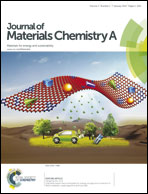A europium(iii) based metal–organic framework: bifunctional properties related to sensing and electronic conductivity†
Abstract
The accessible interspace of [Eu4(BPT)4(DMF)2(H2O)8] (EuL) metal–organic framework (MOF) based host materials can serve as good candidates for loading of a variety of guest molecules. In this regard, two functional properties, sensing and electronic conductivity of EuL MOF were systematically studied in this contribution. The photoluminescent properties reveal that the EuL exhibits characteristic red emission of Eu3+ ion, and presents highly detectable luminescence responses for Cu2+ ions and acetone molecules in DMF solution. For the studies of electrical properties, they were focused on the electronic conductivities of I2-incorporated EuL in anhydrous media and at different temperatures. With the increase of temperature from 25 to 80 °C, the I2-incorporated EuL showed significant changes in conductivities from 8.27 × 10−7 S cm−1 to 2.71 × 10−5 S cm−1. Meanwhile, the activation energy (Ea) was for the first time estimated for iodine-element-incorporated MOF with the help of Arrhenius plots. The successful achievements of the impedance measurements and analyses for I2-incorporated EuL prove for the first time that iodine-element-incorporated MOF can also be used for studies of conductivity under anhydrous conditions and at moderate temperature.


 Please wait while we load your content...
Please wait while we load your content...